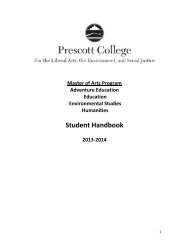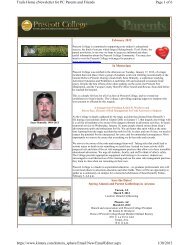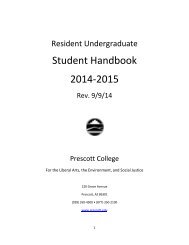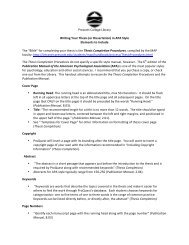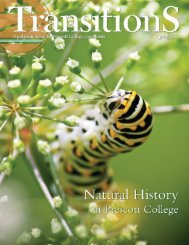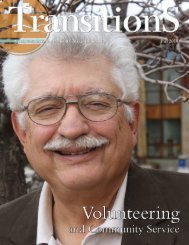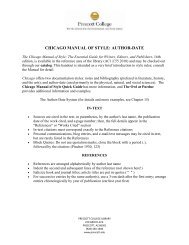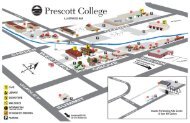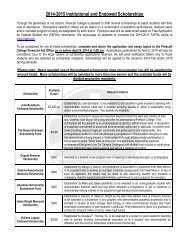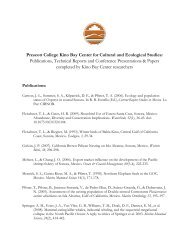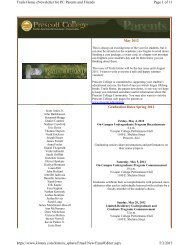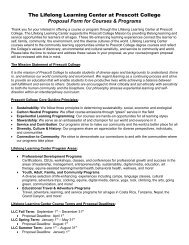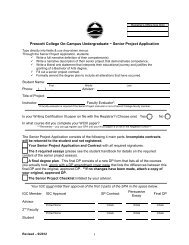Transitions Magazine - Fall 2012 - Prescott College
Transitions Magazine - Fall 2012 - Prescott College
Transitions Magazine - Fall 2012 - Prescott College
You also want an ePaper? Increase the reach of your titles
YUMPU automatically turns print PDFs into web optimized ePapers that Google loves.
Women’s Studies at <strong>Prescott</strong> <strong>College</strong>:<br />
The Beginnings<br />
By Lisa Stewart Garrison ’75<br />
By the late 1960s and early 70s, as feminism swept the<br />
country, dramatically changing what women expected<br />
of themselves and each other, the seeds of the women’s<br />
movement were taking root at <strong>Prescott</strong> <strong>College</strong>. With its slogan<br />
“the personal is political,” feminism was primarily impacting urban<br />
centers. Few would have predicted that young women at a secluded<br />
college campus in the chaparral country of the Granite Dells of<br />
Central Arizona might be emboldened to develop courses of study<br />
and ways of living and talking together that would contribute to the<br />
broader movement and transform the lives of those of us involved.<br />
In many ways, fertile ground for women’s empowerment was<br />
in place by 1968 when <strong>Prescott</strong> <strong>College</strong> formally launched its<br />
signature three-week Wilderness Orientation Program. The first<br />
cadre of young women participated in intensive hiking, kayaking,<br />
river rafting, and mountaineering; faced physical challenges, took<br />
risks, and engaged in cooperative teamwork, gaining newfound<br />
confidence in their strength and problem solving abilities. Three<br />
days spent alone in the wilderness nurtured qualities of self-reliance<br />
and a sense of spiritual connection with nature.<br />
Yet as classes formally began, women<br />
students quickly learned that experiencing<br />
competence in wilderness settings and<br />
knowing how and when to use words to<br />
confront sexism were very different things.<br />
At <strong>Prescott</strong> <strong>College</strong>, in that era, men greatly<br />
outnumbered women on the faculty and in the<br />
syllabi. Out of a faculty of 37, only three were<br />
women. As women students we embraced<br />
<strong>Prescott</strong>’s philosophy of taking individual<br />
responsibility for directing one’s own education.<br />
We were learning to read maps and to<br />
map out our lives. But we were also searching<br />
for role models and determined to find faculty<br />
on campus to help us articulate our insights.<br />
<strong>Prescott</strong> <strong>College</strong>’s first women’s<br />
consciousness raising group met at the<br />
school’s newly opened Center for the<br />
Person on October 19, 1970. We found<br />
our faculty mentor in Heather Keen<br />
(now Heather Starsong), who had<br />
arrived on campus to teach modern<br />
dance and establish ayoga program.<br />
A group of 12 to 15 of us met weekly,<br />
throughout the year, verbalizing<br />
feelings and perceptions previously<br />
left unsaid, grappling with our increasing<br />
anger, and finding our common<br />
ground as women.<br />
Although at first reluctant to serve in an advisory capacity,<br />
Heather stepped in, on condition that we accept her as a fellow<br />
learner, since she didn’t claim this issue to be within her area of<br />
expertise. Feminism was focusing on women and their bodies at<br />
that time, but the emphasis was on reproductive rights, access to<br />
8<br />
<strong>Transitions</strong> <strong>Fall</strong> 2014<br />
healthcare, sexuality, and self-defense. Heather’s commitment to<br />
embodiment through improvisational dance and the inward<br />
journey set a distinctive tone for our explorations. She invited<br />
special guests to meet with us, such as the ritual and ceremony<br />
maker Elizabeth Cogburn. Heather’s grounded presence in a<br />
turbulent time of intense social awakening demonstrated for us<br />
what it is to be an emotionally courageous woman.<br />
The provocative influence of feminist theory and the<br />
intellectual firepower of<br />
Peggy Rourke and Sarah White, 1972, by Beliz Brother<br />
confrontation were alive<br />
and well among women<br />
at <strong>Prescott</strong> <strong>College</strong> in<br />
the early 1970s. A feminist<br />
critique of the<br />
Orientation Program<br />
began to emerge. Give<br />
us experiences that lead<br />
us out of our comfort<br />
zone, by all means. But<br />
Outward Bound’s creed<br />
then—“To Strive, To<br />
Seek, To Find, and Not<br />
To Yield” (Alfred Lord Tennyson)—<br />
evoked a summit mentality, a push for<br />
the peak, and an unwillingness to surrender<br />
that was increasingly discomfiting<br />
to women.<br />
A group of us set up a feminist<br />
dorm. Hot-off-the-press feminist<br />
manifestos, forwarded to us by my<br />
sister in California, were coveted like<br />
contraband. Dog-eared copies of the<br />
women’s newspaper Off Our Backs were<br />
passed from room to room. We were<br />
yearning to read literature by women<br />
and to find heroines whose journeys<br />
might inspire our own.<br />
In the fall of 1971 fellow women students approached me to<br />
teach the <strong>College</strong>’s first women’s literature class. We organized<br />
ourselves as an Independent Study with Heather Keen and<br />
literature professor Dr. Stan Witt serving as faculty advisors. By<br />
the following spring, 25 women were enrolled.<br />
We supplemented a syllabus of novels by women with<br />
readings of feminist theory and criticism, acquired through<br />
pilgrimages to bookstores in Phoenix and Berkeley. We were<br />
making our way through the writings of Shulamith Firestone, Kate<br />
Millet, and Robin Morgan. The poetry books of Sylvia Plath, Anne<br />
Sexton, and Judy Grahn were on perpetual reserve for us in the<br />
library. Throughout the spring of 1972, we met each Monday<br />
evening in an old grey farmhouse off campus (then home to a<br />
group of <strong>Prescott</strong> students and their small herd of goats).<br />
Inspired by our readings, our conversations ranged from<br />
women’s changing identities, to women loving women, and<br />
Women’s<br />
Literature at<br />
<strong>Prescott</strong> <strong>College</strong> was my<br />
entry point to everything. What<br />
we read and talked about, where<br />
we met, who we understood<br />
ourselves to be, opened the door<br />
to what I would study, whom I<br />
would love, how I would live<br />
and work.<br />
—Melanie Lohmann ’75<br />
Lisa S. Garrison, 1972



